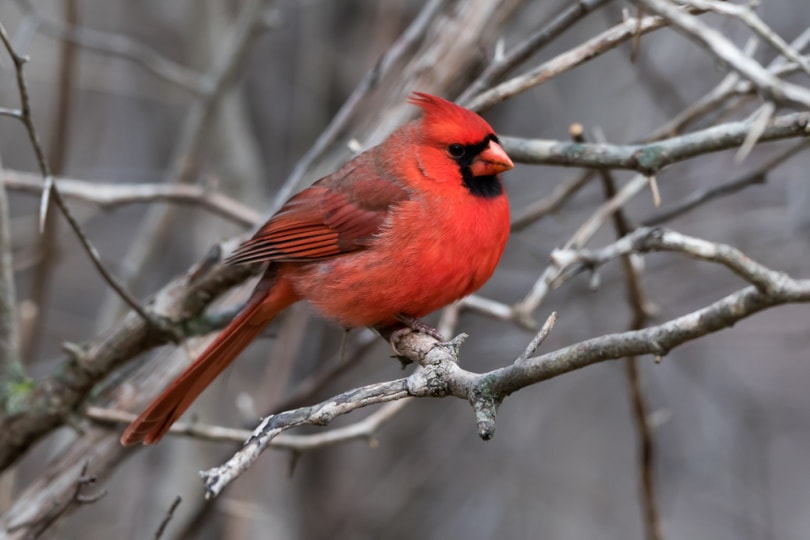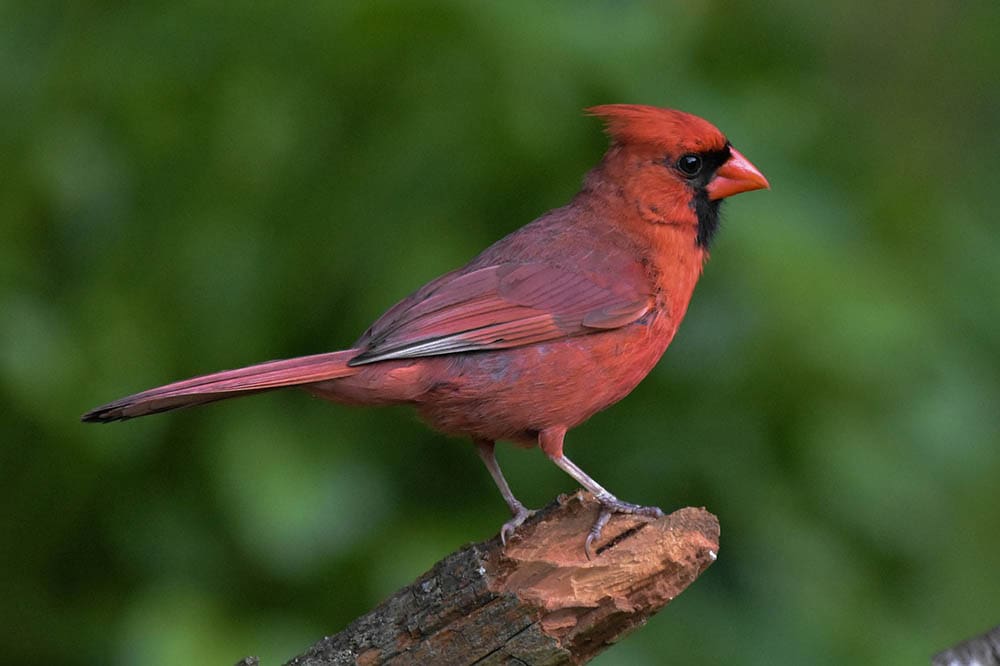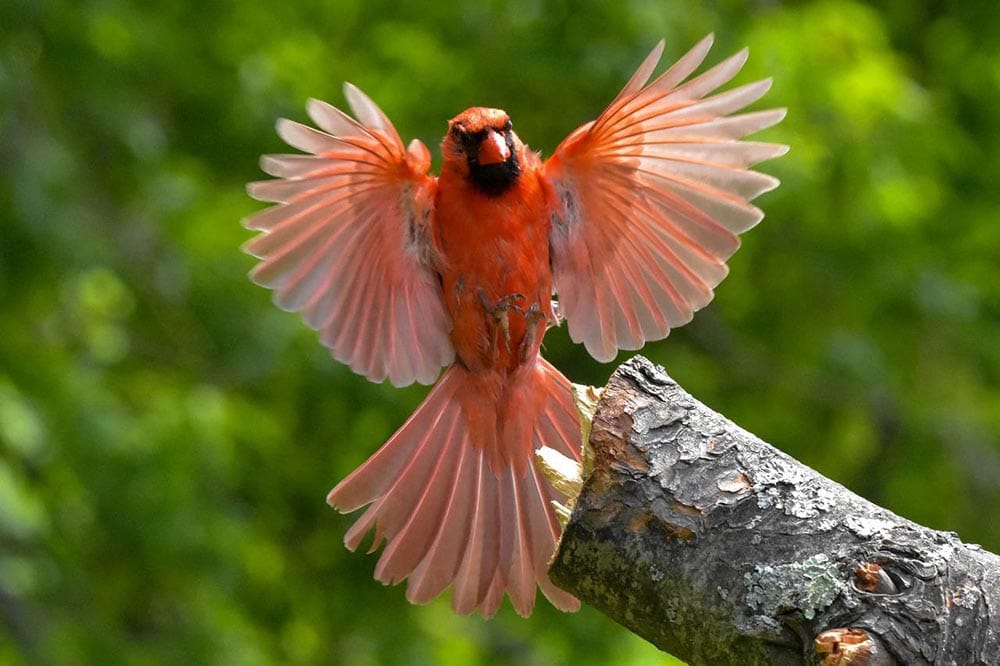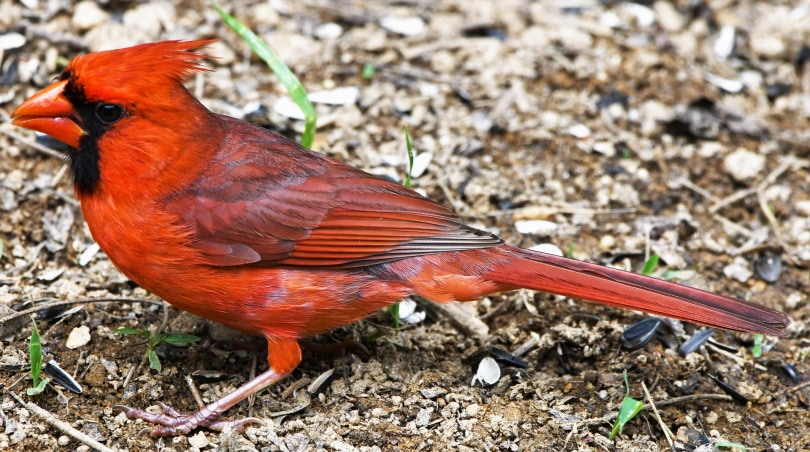Northern Cardinal: Field Guide, Pictures, Habitat & Info
Last Updated on

The Northern Cardinal has become one of the most beloved birds in North America. In fact, seven states have named the Northern Cardinal their official state bird. Needless to say, people everywhere love this stunning species.
If you are new to birdwatching, one of the best birds to start out with is the Northern Cardinal because of its distinctive look. As you begin learning how to inspect a bird from a distance, the Northern Cardinal can teach you a lot.
Keep reading for our complete field guide about Northern Cardinals.

Quick Facts About the Northern Cardinal
| Habitat | Woodland edges, thickets, gardens |
| Diet | Mainly seeds, berries, and insects |
| Behavior | Ground foragers, common at bird feeders |
| Nesting | Dense thickets |
| Conservation | Least concern |
| Scientific name | Cardinalis Cardinalis |
| Lifespan | 3 years in the wild, 20 years in captivity |
Northern Cardinal General Description
The Northern Cardinal is considered a large, long-tailed songbird. It has a short but thick bill with a prominent crest. They often have a hunched-over sitting posture where their tail points straight down. The bird is just slightly smaller than a robin.
The most distinctive aspect of the cardinal is its color, especially for males. Males have a vibrant red color all over. The face is black with a reddish bill, but all its feathers are crimson red.
Females aren’t quite as noticeable, but they are still beautiful. Their body is a pale brown with warm reddish tinges located on the crest, wings, and tail. They have the same black face and red-orange bill as the male.

Northern Cardinal Range, Habitat, Behavior, Diet & Nesting
Northern Cardinals are a species that can be found all over North America. They prefer to sit in shrubs and trees so they can forage on the ground, often in pairs. They frequent bird feeders often and are very bold.
Range
The Northern Cardinal’s range is extensive. It can be found as far north as southeastern Canada and as far south as Mexico, Belize, and even Guatemala. Recently, Northern Cardinals have also been introduced to new locations, such as Bermuda and Hawaii.
Habitat
Northern Cardinals prefer to be around shrubby forest edges. As a result, you can find them in backyards, parks, and woodlots. They aren’t very picky as long as they can find a nest in dense shrubs and vines.
Behavior
Cardinals prefer to forage on the ground or in low bushes. Occasionally, they will go higher in trees, but they are very common at bird feeders. They especially love sunflower seeds. When foraging, it’s common to see two at a time.

Diet
These beautiful red birds mainly have a diet of seeds, berries, and insects, but their diet is varied. Most cardinals will eat just about any insect they can get ahold of, but they prefer vegetable matter such as flowers, fruit, berries, and seeds.
Nesting
Much like many other bird species, males will defend the nesting territory during courtship season. While courting, males and females both raise their heads high and sway while they sing softly. Males will often feed females early on in the breeding season. Females start singing before nesting.
Speaking of actual nesting, the nests are typically very well hidden. Females prefer to nest in dense shrubs, low trees, and vines. They are normally only placed 3–10 inches above the ground, but they can sometimes be found higher.

How to Find a Northern Cardinal: Birdwatching Tips
Because Northern Cardinals have such a distinct appearance, you don’t have to look too hard to find one, especially if you live in the southeastern United States. Still, here are some tips for finding Northern Cardinals in your area.
What to Listen For
Northern Cardinals have a loud but short song that typically only lasts 2–3 seconds. The song often sounds like a two-part whistle that often sounds like “cheer, cheer” or “birdie, birdie, birdie.” Females are most likely to sing before nesting.

What to Look For
Looking out for male Northern Cardinals is not difficult. If you see a vibrant red bird with a prominent crest, it is almost guaranteed to be in Northern Cardinal. As for the females, look for red tinges on the tail, wings, and crest. The crest is still prominent on the females. Both sexes have short, thick, and red beaks.
When to Look
It’s best to look for Northern Cardinals whenever you are in the eastern United States. They are common around shrubby, forested edges, including backyards, woodlots, and parks.
Attracting Northern Cardinal to Your Backyard: Tips & Tricks
Unlike many species, attracting a Northern Cardinal to your home is not difficult, especially if you live in the eastern United States. These birds are very easy to attract if you have the right food.
Set up a bird feeder that is specifically designed with treats cardinals love. Cardinals love black oil sunflower, mealworms, and other parts of the sunflower. You can easily find Northern-Cardinal-specific bird feed at just about any store that sells bird feed.

Northern Cardinal Conservation: Is This Bird Threatened?
Northern Cardinals are not threatened at all. In fact, they are considered to be of least concern. This explains why they are so easily found all throughout the nation and North America.

Final Thoughts
The next time you go out in a wooded area, keep a lookout for a Northern Cardinal. Northern Cardinals have a distinctive look that is next to impossible to miss. Plus, they are bold and have vibrant personalities to match their stunning appearances.
Definitely consider adding Cardinal birdseed to your bird feeder if you want to see more red cardinals. These birds are known to hang out at bird feeders once they find the feeder.
Featured Image Credit: FotoRequest, Shutterstock
Table of Contents
- Quick Facts About the Northern Cardinal
- Northern Cardinal General Description
- Northern Cardinal Range, Habitat, Behavior, Diet & Nesting
- How to Find a Northern Cardinal: Birdwatching Tips
- Attracting Northern Cardinal to Your Backyard: Tips & Tricks
- Northern Cardinal Conservation: Is This Bird Threatened?
- Final Thoughts
About the Author Robert Sparks
Robert’s obsession with all things optical started early in life, when his optician father would bring home prototypes for Robert to play with. Nowadays, Robert is dedicated to helping others find the right optics for their needs. His hobbies include astronomy, astrophysics, and model building. Originally from Newark, NJ, he resides in Santa Fe, New Mexico, where the nighttime skies are filled with glittering stars.
Related Articles:
10 Types of Hummingbirds in Arkansas (With Pictures)
8 Types of Hummingbirds in Nebraska (With Pictures)
5 Types of Hummingbirds in Idaho (With Pictures)
3 Types of Hummingbirds in Mississippi (With Pictures)
8 Types of Hummingbirds in Kansas (With Pictures)
5 Types of Hummingbirds in West Virginia (With Pictures)
5 Types of Hummingbirds in Ohio (With Pictures)
Where Do Nuthatches Nest? Nuthatch Nesting Habits Explained
